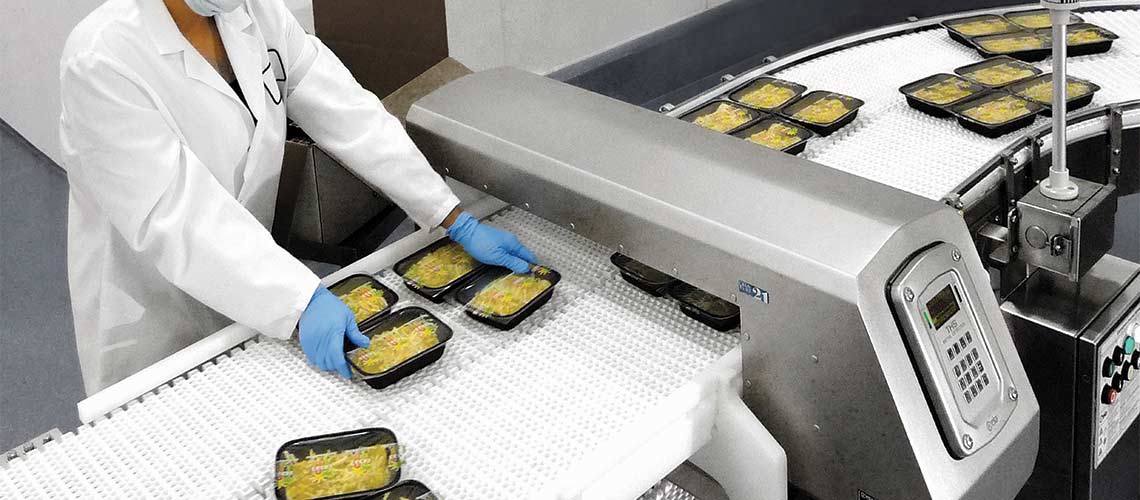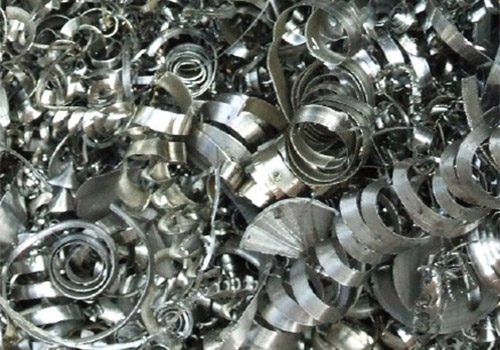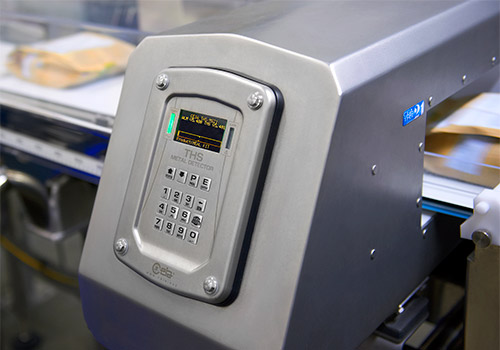Metal is one of the most commonly found contaminants in food and can be introduced at all stages of food manufacturing. By identifying metal contaminants during processing or packaging, a metal detector helps ensure the safety and the integrity of a wide range of unpackaged, packaged, or bulk goods and helps to eliminate metal contaminants from a food manufacturer’s finished product.

Metal is one of the most common contaminants in the food manufacturing industry because it is a fundamental component of the manufacturing equipment and machinery itself. Many machines used in harvesting and processing food are comprised primarily of metal, and as a result, metal can be found in multiple different stages of food manufacturing. Despite diverse precautions, metal contamination during the food production process cannot be fully eliminated. Metal detectors are commonly used by food manufacturers to protect both the product the consumers receive and the equipment used in manufacturing the product from metal particles that either enter the processing system during the production process or that already were present in the raw material caused by tanks, pipelines, the delivery methods, and/or the production staff.
Beyond serious injuries to consumers, which can result in compensation claims and expensive recalls, the damage caused by the negative brand image and the loss of consumer trust caused by impure food products is potentially more serious, long lasting, and irreversible. Therefore, protecting the brand in the marketplace is crucial for food manufacturers. Even one safety recall event is enough to ruin years of establishing a good reputation.
In addition to consumer protection, metal detectors also are used to protect machinery. Even small metal particles can lead to machinery failure resulting in expensive repairs, production downtimes, and revenue decreases.
 In the food manufacturing industry, the contaminants can be in the forms of wires, shavings, and flakes, all of which may not always obvious to the naked eye, especially when workers have a tiny window to observe product in process. The three primary groups of metal contaminants are ferrous, non-ferrous, and stainless steel:
In the food manufacturing industry, the contaminants can be in the forms of wires, shavings, and flakes, all of which may not always obvious to the naked eye, especially when workers have a tiny window to observe product in process. The three primary groups of metal contaminants are ferrous, non-ferrous, and stainless steel:
Ferrous metal contaminants: magnetic and conductive, usually easy to detect, (e.g., alloy steels, carbon steel, iron).
Non-ferrous metal contaminants: non-magnetic but excellent conductors, relatively easy to detect (e.g., aluminum, brass, copper, lead, nickel, tin, zinc).
Stainless steel contaminants: non-magnetic and poor conductors, these foreign bodies are hard to detect. Also, detecting stainless steel is especially problematic when the product is wet because the signal generated by the stainless steel is similar to the product.
If a food manufacturer regularly has issues with calcified bone, ceramics, glass, or stone, an X-ray inspection system can address these contaminants, as well as provide more enhanced detection capabilities. Using both methods with food products help to reduce contaminants and to enhance quality control.
 There are several types of metal detectors, and each uses a different detection method to operate. In the food industry, metal detectors usually apply the balanced coil method. These metal detectors are equipped with a transmitter coil, which generates an electromagnetic field, and two receiver coils. The receiver coils have an equal but opposite output, creating a balanced state. When a conductive object passes through the detector, it interrupts the balanced state of the electromagnetic field and causes a signal that is detected by the receiver coils. The electronic unit in the metal detector then analyzes this signal, evaluates it, signals a metal detection, and either activates the automatic reject units that separates the contaminated product from the production line or alerts the operators.
There are several types of metal detectors, and each uses a different detection method to operate. In the food industry, metal detectors usually apply the balanced coil method. These metal detectors are equipped with a transmitter coil, which generates an electromagnetic field, and two receiver coils. The receiver coils have an equal but opposite output, creating a balanced state. When a conductive object passes through the detector, it interrupts the balanced state of the electromagnetic field and causes a signal that is detected by the receiver coils. The electronic unit in the metal detector then analyzes this signal, evaluates it, signals a metal detection, and either activates the automatic reject units that separates the contaminated product from the production line or alerts the operators.
Metal detectors are strategically placed based on areas where foreign materials can enter the production stream. If consumer protection is the goal, several inspection points are useful. Inspection of raw material catches metal particles before they are broken into smaller pieces which tend to be harder to detect. If the metal detector is used for machinery protection, it is installed directly before the machine requiring protection. Inspections at critical control points (i.e., hazard analysis critical control points) during the production process are recommended so operators are alerted of machinery failures (e.g., broken blades, missing hardware) in a timely manner.
Consequently, after packaging, food products often are inspected at their final stage with a metal detector (and/or an X-ray system) to fully exclude contamination before being sent to the retailers’ shelves.
For optimal product protection, an inspection of raw materials at several critical control points and a final inspection of the finished product are recommended.
Some products contain salt, iron, and moisture—each of these can alter the detector’s field and can trigger a false detection. This effect increases with higher inspection frequencies that are typically used to detect smaller particles and can lead to significant levels of wasted product and downtime.
It is not uncommon to use a reduced frequency to minimize the number of false detections, but this procedure also reduces the ability of the detector to identify non-ferrous and stainless steel contaminants.
Single frequency
The majority of metal detectors on the market use only one frequency when inspecting product. The selected operating frequency depends primarily on the product being inspected. This is satisfactory when the product is dry and non-conductive. Single frequency metal detectors have limited abilities to work with different products and are difficult to optimize for varying conditions of temperature, water content, and packaging types.
Multi-frequency
Using a metal detector that offers more detection frequencies can result in more sensitive metal detection and fewer product effect errors, as well as being able to use the machine on products with differing characteristics.
There are multi-frequency metal detectors that offer several operating frequencies. However, these machines can only use one of the available operating frequencies at a time. The operator may need to switch from one frequency to another when changing products, or in more advanced multi-frequency systems, the metal detector will switch back and forth between two or more frequencies in rapid succession. However, only one frequency (one electromagnetic field) is capable of ever being on at any given time, and to prevent false rejections on more difficult product, reducing the sensitivity typically is still required.
Multi-spectrum
Finally, there are multi-spectrum metal detectors. These metal detectors operate over an entire spectrum of frequencies that are simultaneously analyzed and applied to completely eliminate product effect and allow for an improved inspection of the product. The advantages of these metal detectors are most pronounced when inspecting larger or more complicated items.
For example, at a minimum as a final check before being shipped to store shelves, the final product is inspected by a metal detector after packaging at the end of the production line. The packages of the final product can be quite large, and especially if inspected after individual packages are placed together in a case. And as the metal detector aperture size increases, especially the height, the greater the impact is on the ability to detect smaller particles of metal. With more conductive products such as meat and cheese, maintaining as small an aperture as possible becomes even more critical to sensitivity.
Only one metal detector manufacturer currently offers multi-spectrum technology. CEIA's innovative technology uses a spectrum of multiple frequencies simultaneously and continuously, which are capable of cancelling out a much wider range of product signals. This means more production time per shift because there is no downtime between changes in the product on the line or for rework of rejected product In addition, the cancelling of product signal often allows for detection of smaller pieces of metal. CEIA’s cutting-edge multi-spectrum technology can accommodate for variations in product due to temperature, moisture, and orientation.
Also, CEIA’s simple Global Auto-Learn system functionality allows their metal detectors to be easily set up for new products while ensuring high levels of sensitivity. The metal detector gives feedback on the level of sensitivity in real-time on completion of auto-learn, eliminating the need to configure with test pieces. Product variations that can trigger false rejects can be eliminated using CEIA's background auto-learn function. Standard metal detectors in the marketplace falsely reject good products due to the inability to compensate for product variation usually when food composition, temperature and mineral levels incorrectly indicate the presence of metal. Multiple simultaneous frequencies allow a CEIA metal detector to compensate for variations in product effect making them extremely efficient for a wide range of products. Their metal detectors offer the industry’s highest sensitivity to all magnetic and non-magnetic metals, including stainless steel, CEIA MS21 detectors accurately differentiate between product effect and metal contaminants with no need to reduce sensitivity.
CEIA’s integrated auto-learn selects the spectrum of most effective frequencies and their characteristics, as well as the optimal sensitivity setting to eliminate guesswork and inspection errors. The detector continuously tests and re-calibrates itself to compensate for environmental conditions. Data for every detection and rejection action are saved for programming, testing, and compliance with FDA Title 21 Part 11 requirements for event tracing. One-button preview of detection setting increases set-up speed and accuracy. Combined with memory for over 500 products, this provides fast, error-free changeovers.
Because metal detection specifications need to vary according to the product, the manufacturing process, and the placement in the production line, CEIA multi-spectrum metal detectors provide food manufacturers with the ability to customize detection to their specific application from raw product input to protecting machinery to higher sensitivity metal detection at the end of the line to protect the consumer and the company brand.
Product Manager - Inspection Systems, North America